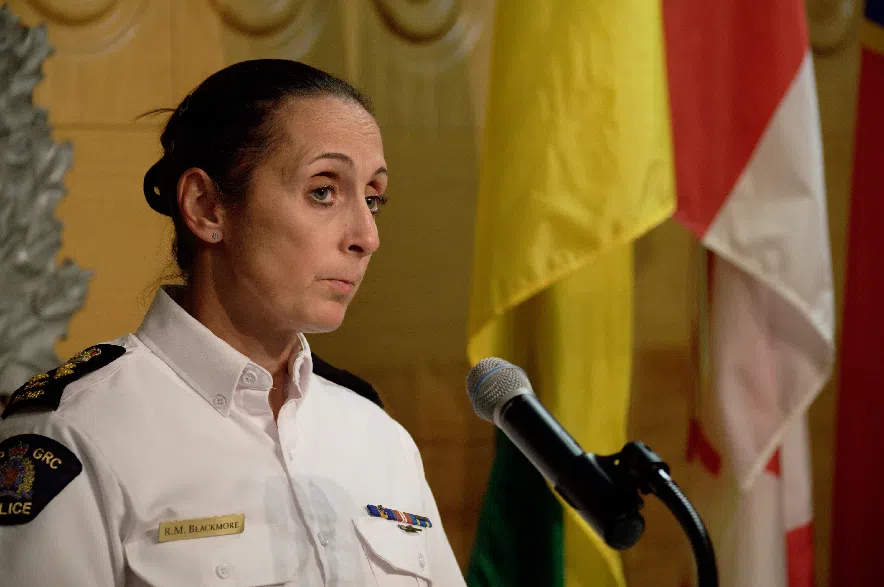By Glynn Brothen
Shortly before a mass stabbing on the James Smith Cree Nation, Rhonda Blackmore, the commanding officer of the Saskatchewan RCMP, conducted a tabletop exercise with her team that she says was “eerily similar” to the one her members experienced in real life.
Her members practiced an active shooter scenario that included mass casualties. The enactment included “injects,” or events that could complicate or derail an investigator’s plan.
One of the thoughts to cross the assistant commissioner’s mind during the exercise was whether the existing RCMP command structure was the most effective for a mass casualty incident. And when that incident came to pass three weeks after the exercise, it wasn’t, according to an internal RCMP report.
The mass stabbing incident, which began in the early morning hours of Sept. 4, 2022, resulted in 10 homicides on the James Smith Cree Nation and one in neighbouring Weldon, followed by a three-day manhunt for the suspect. By the numbers, the incident drew out 549 police resources, led to 700 evidence exhibits, five aircraft, and more than 40 crime scenes.
READ MORE:
- RCMP report reviews police actions after JSCN, Weldon murders
- JSCN addictions worker says without changes, there could be ‘more Myles Sandersons’
- Sask. RCMP ‘proud’ of JSCN response, reviews recommendations
The report that was released last week reviewing the incident and the RCMP response was written by RCMP brass and investigators from across the country. It noted that in the face of the rapidly growing incident, officers faced confusion on who to report to, or whose role it was to delegate.
“The issue was that some of the roles were not formalized,” Blackmore said in an exclusive interview with paNOW.
It’s “the luxury of time and hindsight,” she said. “You look back and think ‘yes that’s right; it could have been done better.’”
The Saskatchewan RCMP has since adopted the Gold, Silver, Bronze plan, the same plan that’s in place for Mounties in Alberta and B.C. The plan outlines a command structure hierarchy with specific focus on tactics, operations and strategy. Blackmore said the plan can adapt to active shooter, mass casualty, and natural disaster situations.
Despite the blueprint, there are times where protocols are abandoned in favour of public safety. Blackmore said one of those calls was her own – and it was a wrong one – when she issued the alert warning Regina residents the suspect, Myles Sanderson, and his brother Damien may have been in the Queen City.
“I think given the information I had at the time, I would probably make the exact same call. The information that came in to us… this caller was saying ‘I’m 100 per cent certain I just saw the vehicle with that licence plate and those individuals in it in Regina,’” she said.
“We now know that wasn’t the case… Damien was already deceased at that point and that Myles was not here in the city. To me, it’s a call I had to make. I would rather make the call where people are a little on edge because of an alert that had gone out to inform them rather than them being harmed because we sat on the information too long and didn’t tell them.”
The Saskatchewan RCMP issued 14 public alerts over the three days before Sanderson’s arrest, keeping in line with Blackmore’s personal views of increased transparency to avoid the public “filling in the blanks.”
Maintaining trust and relationships was another recommendation from the report, as the residents of James Smith Cree Nation continue to heal. Participating in local events and getting to know the community at large before a moment of crisis is invaluable, Blackmore said, adding the RCMP’s relationship with the First Nation is “really strong by all accounts.”
“I’m on a first-name basis with many of the individuals there from James Smith, but so is my detachment commander and so are members at Melfort Detachment,” she said, noting the James Smith Cree Nation’s 28-member security team keeps regular contact with officers.
Blackmore attended a cultural event on the First Nation last week to take part in activities ranging from skinning a moose to making bannock.
“It really goes a long way in the community,” she said.
As for northern Saskatchewan, Blackmore noted there are challenges with policing from limited radio coverage (now supported by improved portable satellites), wide geography and isolation.
“That doesn’t mean we have any less commitment or dedication to their safety and security,” she said.











